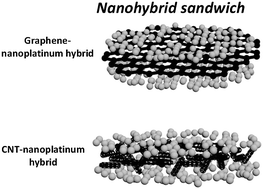A comparative study of carbon–platinum hybrid nanostructure architecture for amperometric biosensing†
Abstract
Carbon and noble metal nanomaterials exhibit unique properties that have been explored over the last few decades for developing electrochemical sensors and biosensors. Hybridization of nanometals to carbon nanomaterials such as graphene or carbon nanotubes produces a synergistic effect on the electrocatalytic activity when compared to either material alone. However, to date there are no comparative studies that directly investigate the effects of nanocarbon concentration and nanocomposite arrangement on electron transport. This comparative study investigated the efficacy of various platinum–carbon hybrid nanostructures for amperometric biosensing. Electroactive surface area, sensitivity towards hydrogen peroxide, response time, limit of detection, and surface roughness were measured for various hybrid nanomaterial arrangements. Both design factors (nanocarbon concentration and network arrangement) influenced the performance of the reduced graphene oxide-based platforms; whereas only nanomaterial arrangement affected the performance of the carbon nanotube-composites. The highest sensitivity towards hydrogen peroxide for reduced graphene oxide nanocomposites (45 ± 3.2 μA mM−1) was measured for a graphene concentration of 2 mg mL−1 in a “sandwich” structure; nanoplatinum layers enveloping the reduced graphene oxide. Likewise, the best carbon nanotube performance toward H2O2 (49 ± 1.4 μA mM−1) was measured for a sandwich-type structure with nanoplatinum. The enhanced electrocatalytic activity of this “sandwich” structure was due to a combined effect of electrical junctions formed amongst nanocarbon, and nanocomposite soldering to the electrode surface. The top-down carbon–platinum hybrid nanocomposites in this paper represent a simple, low-cost, approach for formation of high fidelity amperometric sensors with remarkable performance characteristics that are similar to bottom-up fabrication approaches.


 Please wait while we load your content...
Please wait while we load your content...